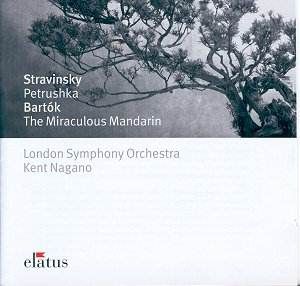Kent Nagano is a conductor who is particularly associated
with the repertoire of the 20th century, and he is certainly at home
in these great ballet scores by Stravinsky and Bartók. So too
is the LSO, captured on excellent form during these recording sessions
held in 1997. And to complete the contributions which help make this
such an attractive issue, the engineers have secured both natural and
wide-ranging sound.
Nagano opts for the revised 1947 version of Petrushka,
which Stravinsky rescored for a smaller, more 'normal' orchestra than
the ensemble he had been encouraged to use in the original version for
Diaghilev's Ballets Russes back in 1911. It is still a full symphony
orchestra, however, and the music is in no sense compromised, even though
some of the opulence of the first version is lost.
The performance is keen-edged from the rhythmic point
of view, which is no bad thing in this music. For example, the multi-layered
rhythms of the first tableau, At the Shrove-Tide Fair, really do create
an impression of excitement and bustling activity. Likewise the famous
Russian Dance makes is strongly characterised, with a fast tempo but
at the same time a clear sense of articulation. Another highlight is
the colourful episode featuring the peasant and his bear, scaring the
members of the crowd as he comes close to them. There is real poignancy,
moreover, in the later stages dealing with Petrushka's death and the
vision of his ghost. With intelligently detailed cue points, this becomes
a most attractive proposition.
Bartók's ballet The Miraculous Mandarin has
at least its rhythmic vitality in common with Petrushka. But
look a little deeper and the differences emerge one upon another. To
begin with, Bartók's work did not achieve the instant success
that Stravinsky enjoyed in Paris in 1911, and was actually banned by
the censor for many years. In order to find the music some performances,
Bartók made an orchestral suite, and though this is effective
enough in the concert hall, it does exclude some of the best music from
the original. But it is the original version that Nagano performs here,
which means the addition of the wordless voices of the LSO Chorus in
the later stages of the work.
This tale of low-life violence and prostitution requires
a vivid and dramatic approach, and Nagano and the orchestra do not disappoint.
There are also some distinguished contributions by several LSO principals.
For example, the clarinet is very good in the various 'decoy games',
as the thugs use the girl to lure their victims into the room so that
they can rob them. But the third of the victims is the Mandarin, a strange
and mysterious figure whose obsession with the girl he craves brings
a new intensity and atmosphere to the music. This is well captured by
both the recording and the performance, although a minor caveat is that
Nagano somewhat underpays the ending, which might be more atmospheric.
Try, for comparison, the Decca recording with the Vienna Philharmonic
conducted by Christoph von Dohnanyi, which succeeds in generating an
extraordinary intensity and atmosphere towards the close, although Nagano
has more biting rhythmic attack in the earlier faster sections.
Again the cue points are detailed and well identified
in the booklet against clearly designed synopses. There is also an excellent
accompanying essay by an unacknowledged writer, who has every right
to be irritated when he or she finds out.
Terry Barfoot


